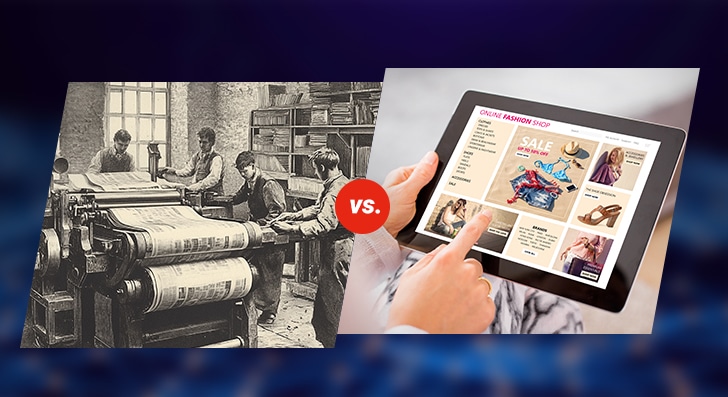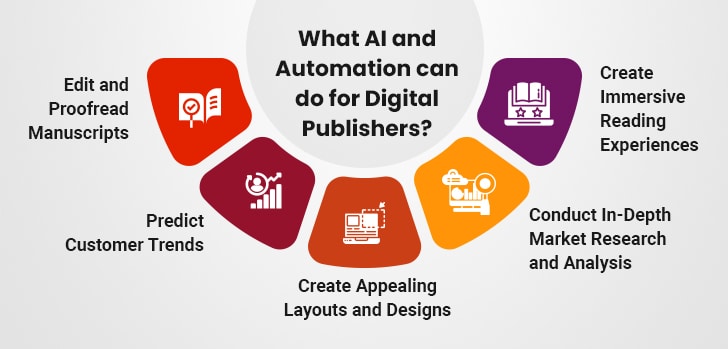The publishing industry has come a long way, from manuscripts to ebooks. Once costly and rare, the invention of the printing press in the 15th century made books affordable. Or, let’s put it this way: Publishers moved from clay tablets to papyrus scrolls. Not only this, but the mass-market paperback in the 20th century made books even more accessible.
The ultimate breakthrough came with the rise of ebooks and digital publishing in the early 21st century. This shift from printing presses to digital publishing came with the adoption of ereading devices. Ereaders, such as Amazon Kindle, Barnes & Noble Nook, Sony Reader, etc., allow readers to access vast libraries instantly. The best part is that readers can access ebooks anytime, anywhere.

On the flip side, the transformation gave rise to self-publishing platforms and online book sales. This helps authors and publishers reach global audiences directly. In short, the publishing industry has always been open to experimenting and keeping up with technological advancements. That said, AI and automation are no exception to it.
Table of Contents
The Role of AI and Automation in Digital Publishing
Applications of AI and Automation in Digital Publishing
Limitations of AI in Digital Publishing
These technologies are not just enhancing classic publishing processes but rewriting the rules of digital publishing services. From content creation to distribution, AI and automation are helping publishers work smarter, engage audiences more effectively, and deliver customized experiences at scale.
Unlocking the Secrets of Digital Publishing: From Conversion to Formatting
The Role of AI and Automation in Digital Publishing
People are skeptical about including AI in the editorial team. After all, creativity and artistic ability are ideally human qualities, right? That’s true. And for now, at least, current AI models may be unable to produce journalistic masterpieces that fit well in the top columns. However, these tools can be used as helping hands for human authors to enhance self-written content. Below are some of the areas where these technologies are making a significant impact:
1. Serving the Readers with What They Want
AI-based recommendation engines have become important tools for digital publishers. These engines recommend personalized content for readers based on their behavior, preferences, and engagement patterns. This improves user experience and boosts content consumption and reader retention.
2. Creating Tags and Metadata to Increase Discoverability
Manually tagging content is labor-intensive and error prone. AI-based tools create tags and metadata based on the context, keywords, and themes of the content. This improves the discoverability of content and ensures it is categorized accurately. Not only this, but automated metadata generation also helps in search engine optimization (SEO), making it simpler for readers to find relevant content.
3. Summarizing Long-Form Content Without Losing Its Essence
In the age of information overload, readers usually look for summaries of long articles or reports. AI-based summarization tools excel in this space. They analyze large amounts of text to provide short summaries without sacrificing the substance of the content. This is helpful for publishers working with academic journals, research studies, and news reports, where readers usually prefer quick notes over in-depth reads.
4. Making Money with the Best Quality Content
AI uses real-time metrics to make money from content. It immediately identifies content with traffic spikes, such as breaking news or a viral story. It instantly activates a specific CTA to maximize the monetization of that content. The best part is that the copy of those CTAs is generated automatically based on content goal, vertical, and sentiment.
5. Generating Novel Content Ideas
Creativity isn’t something that can be turned on or off using a switch. The process certainly takes time and worsens when there’s a creative block. That’s where AI helps with brainstorming and idea generation. In fact, tools like ChatGPT and DeepSeek help overcome writer’s block by producing novel content ideas. A few prompts are required to help the tool understand the context. Based on the inputs, the tools can create detailed characters, plot twists, setting descriptions, and more.
Needless to say, AI is not here to replace humans but to help them. Or let’s put it this way: AI tools don’t mean the death of creative fields; instead, they boost creativity and innovation. From editing and proofreading manuscripts to creating appealing layouts and designs, AI tools help digital publishers in multiple ways.
Applications of AI and Automation in Digital Publishing
Digital publishing is a huge industry. AI and automation help publishers streamline the content creation process. These tools can translate content into multiple languages and check grammar, syntax, and inconsistencies. Thus, publishers can balance quality and quantity when generating content. Take a detailed look at the applications:
I. Editing and Proofreading Manuscripts
AI-based tools like Grammarly and Hemmingway Editor are changing the way editing and proofreading are done. These tools use natural language processing to find grammatical mistakes, suggest better sentence structures, and even tone inconsistencies. This means quicker turnaround times and better-quality content for digital publishers. The advanced tools also help check facts and detect plagiarism, ensuring the trustworthiness of published content. This is a relief for ebook conversion services that always look for innovative ways to balance quality and quantity.
II. Predicting Trends and Reader Preferences
The ability of AI to analyze historical data and find patterns makes it a useful tool for forecasting market trends and reader preferences. Publishers can use this to decide which subjects would appeal to their readers, optimize content calendars, and even forecast sales for books and subscriptions. This approach reduces guesswork and maximizes the impact of content strategies.
III. Creating Appealing Layouts and Designs
Even though it’s said never to judge a book by its cover, some of us surely do. Thus, digital publishers spend a lot of time and resources creating appealing layout designs. AI-based design software such as Canva and Adobe Sensei are doing this automatically. These tools create layouts, choose fonts, and even provide color schemes based on the context of the content. This helps an ebook publishing services company and other publishers be relieved from the worries of maintaining an aesthetic design look.
IV. Conducting Market Research and Analysis
AI analyzes reader data to identify patterns and predict future trends. This information helps publishers better understand their audiences and create content strategies accordingly. They can make smarter choices as well as respond to market changes and customer demands faster. An ebook conversion company can also use these tools to determine the starting print run of books or pricing ebooks.
eBook Conversion, Formatting, and Publishing 101: What, Why, and How
V. Providing an Immersive Reader Experience
AI tools can boost user engagement efficiently. Virtual assistants like Amazon’s Alexa, Apple’s Siri, and Google Assistant add a whole new dimension to the way content is consumed, making it more interactive. These virtual assistants can read articles, books, and other forms of content loud, making it more interactive. Moreover, chatbots recommend articles and guide readers through content to provide a more dynamic, engaging experience.
Going a step ahead, AI also helps publishers and authors convert text into augmented and virtual realities. Thus, writers can develop interactive stories where readers explore 3D environments and experience a first-person narrative. Journalists can use this advanced technology to get suggestions for topics, images, and headlines and optimize their articles for better engagement. Both these trends, integrating AR/VR and using voice assistants, are gradually picking up pace.

All in all, AI and automation empower publishers and writers to improve content quality, design visually appealing covers, and create immersive experiences for their readers that increase engagement. At the same time, using AI in digital publishing raises issues like intellectual property concerns, lack of original creativity, and ethical and moral considerations.
Limitations of AI in Digital Publishing
Despite its impressive capabilities, AI has significant limitations that impact its applications in the digital publishing industry. Understanding these limitations is important to set appropriate roles and boundaries for AI in the creative writing process. Take a look at what these are:
1. Lack of Originality
AI learns from existing data by remixing and repurposing what the model has been fed. By default, the process lacks the natural, original creativity basic to humans. It can copy styles and patterns but struggles to generate original ideas or think out of the box.
2. Indifference Toward Language Details
Human language is nuanced. AI has trouble understanding its context and details. It can misunderstand cultural references, emotions, idioms, etc. This leads to content that may be technically sound but tone-deaf or contextually inapt.
3. Absence of Emotional Intelligence
Emotional intelligence is essential to producing content that resonates with human emotions and experiences. However, AI tools lack emotional intelligence and don’t truly understand them. Thus, there’s a lack of depth in the content produced using these tools.
4. Unclear IP Rights
Intellectual property rights are often blurred with the use of AI-generated content. This is because it becomes unclear who owns the content: the AI creator, the AI user, or no one at all. This is a grave concern as AI can be used for illegal purposes, such as spreading hate speech.
5. Quality vs. Quantity Trade-Off
Even though AI is exceptionally good at producing content at scale, quality and uniqueness are often sacrificed in the process. This mass production of AI content leads to homogenization, with everything becoming and sounding the same.
6. Risk of Spreading Misinformation
AI’s ability to produce content quickly and easily comes with the risk of spreading false information. This can be done either intentionally, as in the case of deepfakes and propaganda, or unintentionally, due to model training on incorrect data sources.
7. Ensuring Factual Accuracy of the Content
Ensuring AI content is factually accurate is also challenging. AI systems can unintentionally spread incorrect and outdated information, especially the ones dealing with large volumes of real-time data. This is a serious issue in fields like education and journalism, where the content influences public opinion and supports stereotypes. Thus, the accuracy of facts and content cannot be negotiated.
8. Ethical and Moral Considerations
AI lacks ethical boundaries and blurs the line between original and fake. Thus, the generated content raises issues of authenticity and plagiarism. Moreover, the tools can be misused to create deepfakes and spread misinformation.
Digital publishers must ensure that the AI tools are trained on accurate and unbiased data. They should implement robust verification processes and establish ethical guidelines for using AI for content creation. The generated content must be thoroughly reviewed for factual accuracy and to avoid its potential misuse.
Nevertheless, the field of AI is a work in progress. Advancements are being made to overcome its shortcomings, and various trends are reshaping the digital publishing industry. Publishers and authors must know what these are to harness the full potential of these advanced technologies.
Get professional Ebook formatting, design, and publishing support.
Latest Trends Reshaping the Digital Publishing Industry
The digital publishing industry is evolving constantly, driven by emerging technologies and changing consumer preferences. Take a look at some of the latest trends that are disrupting the industry for the good:
a. Integrating AR/VR to Improve Reader Experience
AR and VR are transforming the way readers interact with digital content. Digital publishers use these technologies to create immersive experiences, such as interactive 3D models, virtual book tours, and AR-enhanced magazines. This captivates readers and opens up new revenue streams for publishers.
b. Using Voice Assistants for Research
Voice assistants like Alexa and Google Assistant are becoming increasingly popular for researching and consuming content. Publishers are optimizing their content for voice search by using natural language queries and creating audio-friendly formats. This trend is particularly relevant for news publishers and educational content providers.
c. Prioritizing Mobile User Experience
With the majority of Internet users accessing content via mobile devices, publishers prioritize mobile user experience. This includes responsive design, faster loading times, and intuitive navigation. AI plays an important role in optimizing mobile UX by analyzing user behavior and suggesting improvements.
d. Growing Need for Niche Publications
As readers seek more specialized and tailored content, there is a growing demand for niche publications. AI helps publishers identify underserved niches and create content that caters to specific interests. This trend is particularly evident in areas like independent journalism, hobbyist magazines, and industry-specific reports.
Final Thoughts
AI and automation are undeniably writing a new chapter in the book of digital publishing. From simplifying workflows to providing immersive experiences, these technologies enable digital publishers to address the needs of a rapidly evolving digital landscape. However, the journey is not without its challenges. Ethical concerns, the quality-quantity trade-off, lack of emotional intelligence and original creativity, etc., are some of the issues that digital publishers must address to realize the potential of these technologies fully.
As the industry evolves, staying abreast of the latest trends, such as AR/VR integration, voice technology, and niche publications, is important for maintaining a competitive edge. By embracing AI and automation thoughtfully and strategically, digital publishers can unlock new opportunities and redefine the future of content creation and distribution.





